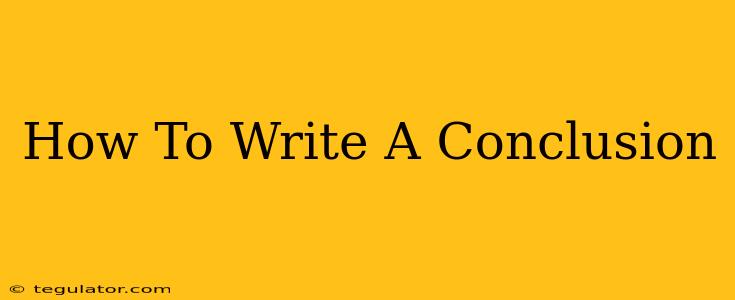Writing a compelling conclusion is often overlooked, but it's crucial for leaving a lasting impression on your reader. A strong conclusion doesn't just summarize; it synthesizes, analyzes, and leaves the audience with a clear takeaway. This guide will walk you through the process of crafting conclusions that resonate and enhance the overall impact of your work, whether it's an essay, a research paper, a presentation, or even a blog post.
Understanding the Purpose of a Conclusion
Before diving into the how, let's clarify the why. A conclusion serves several vital purposes:
- Summarizing Key Points: Briefly reiterate the main arguments or findings you've presented. Avoid simply listing them; instead, weave them together in a concise and insightful manner.
- Synthesizing Information: Go beyond simple summarization. Show how the different parts of your work relate to each other and support your central thesis or argument. This demonstrates critical thinking and a deeper understanding of your subject matter.
- Offering a Final Analysis: Provide a concise, insightful analysis of the information presented. This is your chance to offer a fresh perspective or draw a significant conclusion from the evidence.
- Leaving a Lasting Impression: Your conclusion is the last thing your audience will remember. Make it memorable by offering a thought-provoking statement, a call to action, or a powerful image.
Key Elements of a Strong Conclusion
A powerful conclusion typically incorporates these elements:
1. Restate Your Thesis (But Don't Just Repeat It!)
Reiterate your main point, but avoid simply echoing your introduction verbatim. Refine your thesis statement based on the evidence and analysis presented in your work. This shows growth and understanding.
2. Summarize Key Findings or Arguments
Briefly summarize the key points supporting your thesis. Use concise, impactful language. Think of it as a highlight reel of your main arguments.
3. Offer a Synthesis and Analysis
This is where you show your understanding. Don't just list your findings; explain how they relate to each other and support your central argument. What are the implications of your findings?
4. Provide a Thought-Provoking Statement or Call to Action
End with a powerful statement that leaves the reader pondering your ideas or inspires them to take action. This could be a prediction, a suggestion for future research, a call for change, or a memorable closing thought.
5. Maintain a Consistent Tone and Style
Ensure your conclusion maintains the same tone and style as the rest of your work. Avoid introducing new information or arguments in the conclusion. Maintain consistency and coherence.
Different Types of Conclusions
The best type of conclusion depends on your work's purpose and audience. Here are a few examples:
- Essay Conclusions: Often synthesize arguments, offer a final reflection, and leave the reader with a lasting thought.
- Research Paper Conclusions: Summarize findings, discuss limitations, and suggest future research directions.
- Presentation Conclusions: Summarize key takeaways, reiterate the main message, and often include a call to action.
- Blog Post Conclusions: Offer a final thought, encourage engagement (comments, shares), and sometimes lead to related content.
Avoiding Common Mistakes
- Introducing New Information: Avoid presenting new arguments or evidence in your conclusion.
- Over-Summarizing: Don't simply list your main points; synthesize and analyze them.
- Ending Abruptly: Ensure your conclusion provides a sense of closure and leaves a lasting impact.
- Using Weak Language: Use strong, active verbs and concise language to make your conclusion impactful.
Conclusion: Mastering the Art of the Ending
Writing a strong conclusion takes practice, but mastering this skill dramatically enhances your writing's overall effectiveness. By following these guidelines and avoiding common pitfalls, you can craft conclusions that leave your audience engaged, informed, and impressed. Remember, your conclusion is your final opportunity to leave a lasting impression – make it count!

